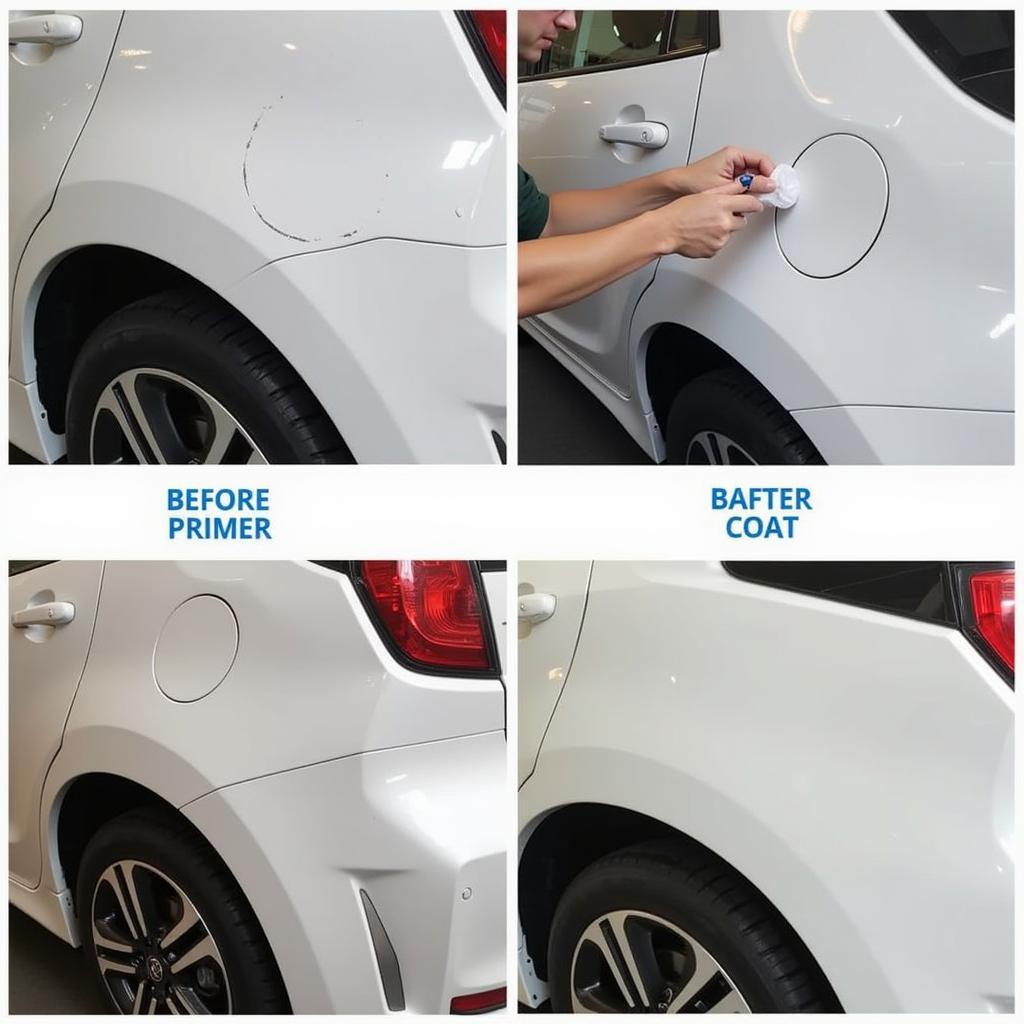A car body hole can be a real eyesore, diminishing your vehicle’s aesthetic appeal and potentially leading to more serious problems down the road. Luckily, with the right car body hole repair kit and a bit of know-how, you can often tackle these repairs yourself and save a significant amount of money. This guide will provide you with everything you need to know about choosing and using a car body hole repair kit, from assessing the damage to achieving a professional-looking finish.
Understanding Car Body Hole Repair Kits
Before diving into the repair process, it’s important to understand the different types of car body hole repair kits available. Choosing the right kit depends largely on the size and location of the hole, as well as the material of your car’s body. car body repair kit for holes can be a great resource for finding the right kit for your specific needs. Some common types include fiberglass resin kits for larger holes and body filler kits for smaller dents and imperfections. You’ll also find metal mesh patches for reinforcing repairs and specialized kits designed for plastic bumpers. Understanding the differences will help you make an informed decision and achieve the best possible results.
Assessing the Damage and Choosing the Right Kit
How do I choose the right car body hole repair kit? The first step is to carefully assess the damage. Measure the size of the hole and consider its location. Is it on a flat surface or a curved area? Is the metal rusted or clean? For smaller holes, a simple body filler kit might suffice. However, larger holes, especially those involving rust, will require a more robust solution, such as a fiberglass repair kit. Consider aluminum car body corrosion repair if your vehicle has aluminum body panels. Don’t forget to check if the area around the hole is structurally sound.
Preparing the Area for Repair
Proper preparation is crucial for a successful repair. Start by cleaning the area around the hole thoroughly. Remove any loose paint, rust, or debris. Use sandpaper to roughen the surface around the hole, creating a better surface for the repair material to adhere to. If there’s any rust present, use a rust converter to neutralize it and prevent it from spreading. Masking off the surrounding area with painter’s tape will protect your car’s paint during the repair process.
Applying the Car Body Hole Repair Kit
What’s the best way to apply a car body hole repair kit? The application process will vary depending on the type of kit you’ve chosen. For body filler, mix the filler and hardener according to the manufacturer’s instructions. Apply the filler to the hole and the surrounding area, using a putty knife to smooth it out. For fiberglass resin kits, cut a piece of fiberglass mat slightly larger than the hole and apply the resin to the mat and the area around the hole. Allow the repair material to cure completely. Once cured, sand the repaired area smooth, blending it with the surrounding bodywork. If you’re working with a car body kit, car body kit repair can offer valuable insights.
Finishing Touches and Painting
After sanding the repair, you’ll need to apply a primer before painting. This will ensure that the paint adheres properly and creates a smooth, even finish. Once the primer is dry, you can paint the repaired area, blending the new paint with the existing paint. A clear coat will protect the paint and give your car a professional-looking shine. For information on working with fiberglass and primer, check out car bodywork repair glass fibre then primer. If you are in the UK and looking for epoxy repair kits, consider car body epoxy with gause repair kits uk.
 Final steps of car body hole repair, including painting and clear coat application
Final steps of car body hole repair, including painting and clear coat application
Conclusion
Repairing a car body hole with a car body hole repair kit can be a rewarding DIY project, saving you time and money. By following these steps and choosing the right kit, you can achieve professional-looking results and restore your car’s appearance.
FAQ
- What is the best car body hole repair kit for rust? A fiberglass repair kit with rust converter is usually the best option.
- Can I repair a hole in a plastic bumper with a car body hole repair kit? Yes, specialized kits are available for plastic bumper repair.
- How long does it take for a car body hole repair to cure? Curing times vary depending on the product used, but it’s generally best to allow 24 hours.
- Do I need to prime before painting a repaired car body hole? Yes, priming is essential for proper paint adhesion and a smooth finish.
- What type of sandpaper should I use for car body repair? Start with a coarser grit (80-100) and gradually move to finer grits (220-320) for a smooth finish.
- Can I use a car body hole repair kit on aluminum? Yes, but be sure to use a kit specifically designed for aluminum.
- Where can I buy a car body hole repair kit? Auto parts stores, online retailers, and some hardware stores carry these kits.
Need more assistance? Contact us via WhatsApp: +1(641)206-8880, or Email: [email protected]. We have a 24/7 customer service team.

